Related Research Articles
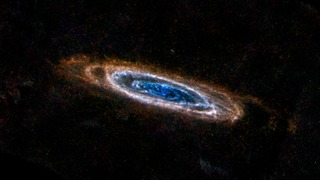
Far-infrared astronomy is the branch of astronomy and astrophysics that deals with objects visible in far-infrared radiation.

Jan Hendrik Oort was a Dutch astronomer who made significant contributions to the understanding of the Milky Way and who was a pioneer in the field of radio astronomy. The New York Times called him "one of the century's foremost explorers of the universe"; the European Space Agency website describes him as "one of the greatest astronomers of the 20th century" and states that he "revolutionised astronomy through his ground-breaking discoveries." In 1955, Oort's name appeared in Life magazine's list of the 100 most famous living people. He has been described as "putting the Netherlands in the forefront of postwar astronomy."

The Atacama Large Millimeter/submillimeter Array (ALMA) is an astronomical interferometer of 66 radio telescopes in the Atacama Desert of northern Chile, which observe electromagnetic radiation at millimeter and submillimeter wavelengths. The array has been constructed on the 5,000 m (16,000 ft) elevation Chajnantor plateau - near the Llano de Chajnantor Observatory and the Atacama Pathfinder Experiment. This location was chosen for its high elevation and low humidity, factors which are crucial to reduce noise and decrease signal attenuation due to Earth's atmosphere. ALMA provides insight on star birth during the early Stelliferous era and detailed imaging of local star and planet formation.

Onsala Space Observatory (OSO), the Swedish National Facility for Radio Astronomy, provides scientists with equipment to study the Earth and the rest of the Universe. The observatory operates two radio telescopes in Onsala, 45 km south of Gothenburg, and takes part in several international projects. Examples of activities:

The Herschel Space Observatory was a space observatory built and operated by the European Space Agency (ESA). It was active from 2009 to 2013, and was the largest infrared telescope ever launched until the launch of the James Webb Space Telescope in 2021. Herschel carries a 3.5-metre (11.5 ft) mirror and instruments sensitive to the far infrared and submillimetre wavebands (55–672 µm). Herschel was the fourth and final cornerstone mission in the Horizon 2000 programme, following SOHO/Cluster II, XMM-Newton and Rosetta.
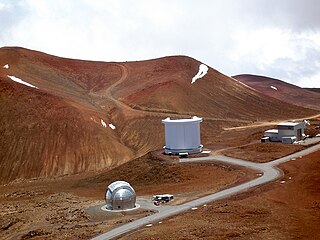
The James Clerk Maxwell Telescope (JCMT) is a submillimetre-wavelength radio telescope at Mauna Kea Observatory in Hawaii, US. The telescope is near the summit of Mauna Kea at 13,425 feet (4,092 m). Its primary mirror is 15 metres across: it is the largest single-dish telescope that operates in submillimetre wavelengths of the electromagnetic spectrum. Scientists use it to study the Solar System, interstellar dust and gas, and distant galaxies.

Owens Valley Radio Observatory (OVRO) is a radio astronomy observatory located near Big Pine, California (US) in Owens Valley. It lies east of the Sierra Nevada, approximately 350 kilometers (220 mi) north of Los Angeles and 20 kilometers (12 mi) southeast of Bishop. It was established in 1956, and is owned and operated by the California Institute of Technology (Caltech). The Owens Valley Solar Array portion of the observatory has been operated by New Jersey Institute of Technology (NJIT) since 1997.

Submillimetre astronomy or submillimeter astronomy is the branch of observational astronomy that is conducted at submillimetre wavelengths of the electromagnetic spectrum. Astronomers place the submillimetre waveband between the far-infrared and microwave wavebands, typically taken to be between a few hundred micrometres and a millimetre. It is still common in submillimetre astronomy to quote wavelengths in 'microns', the old name for micrometre.
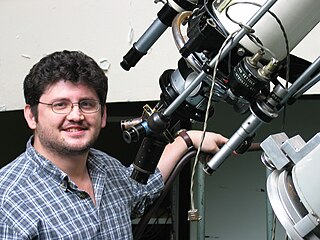
Roberto Abraham, FRSC is a Canadian astronomer and is Professor of Astronomy at the University of Toronto and a Fellow of the Royal Society of Canada.
Patrick Thaddeus was an American professor and the Robert Wheeler Willson Professor of Applied Astronomy Emeritus at Harvard University. He is best known for mapping carbon monoxide in the Milky Way galaxy and was responsible for the construction of the CfA 1.2 m Millimeter-Wave Telescope.

Laura Ferrarese is a researcher in space science at the National Research Council of Canada. Her primary work has been performed using data from the Hubble Space Telescope and the Canada-France-Hawaii Telescope.
Judith Gamora Cohen, is an American astronomer and the Kate Van Nuys Page Professor of Astronomy at the California Institute of Technology. She is a recognized expert regarding the Milky Way Galaxy, particularly with respect to the Galaxy's outer halo. She also played a key role in the design and construction of the Keck Telescope.
Elaine Margaret Sadler is an Australian astrophysicist. She is the Australia Telescope National Facility Chief Scientist and a Professor of Astrophysics in the School of Physics at the University of Sydney. She was elected as a fellow of the Australian Academy of Science (AAS) in 2010 and commenced a 4-year term as Foreign Secretary of the AAS in 2018. She was previously director of the CAASTRO centre (2014-2018).

Origins Space Telescope (Origins) is a concept study for a far-infrared survey space telescope mission. A preliminary concept in pre-formulation, it was presented to the United States Decadal Survey in 2019 for a possible selection to NASA's large strategic science missions. Origins would provide an array of new tools for studying star formation and the energetics and physical state of the interstellar medium within the Milky Way using infrared radiation and new spectroscopic capabilities.
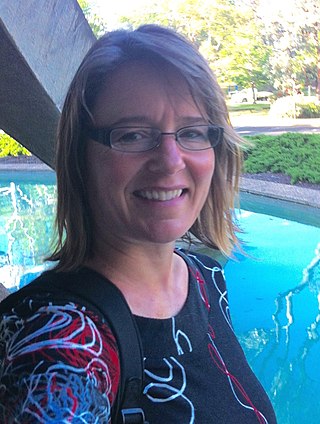
Kim A. Venn is a professor of physics and astronomy at the University of Victoria, Canada, and director of the university's Astronomy Research Centre. She researches the chemo-dynamical analysis of stars in the galaxy and its nearby dwarf satellites.
Sarah Connoran Gallagher is a professor of astronomy at the University of Western Ontario, where her research focuses on active galaxies, black holes and compact galaxy groups. From 2018 to 2022, she also served as Science Advisor to the Canadian Space Agency.
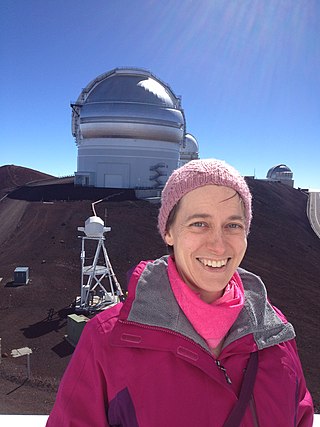
Pauline Barmby is a Canadian astronomer currently based at the University of Western Ontario. She studies galaxies, their formation and evolution from an observational standpoint. She studies both nearby galaxies and those at high redshift using telescopes like the Spitzer Space Telescope. She is the co-chair, with Bryan Gaensler, of the Canadian Astronomy 2020 Long Range Plan.
Kristine Spekkens is a Canadian astronomer, and is a professor at the Royal Military College of Canada and Queen's University. She is the Canadian Science Director for the Square Kilometre Array.
Jean L. Turner is an astrophysicist and distinguished professor in the Department of Physics and Astronomy at the University of California, Los Angeles. She was lead author on research and discovery of a particular star cluster in the dwarf galaxy NGC 5253, considered 'remarkable' for being an extremely dusty gas cloud and having highly efficient star formation.
References
- 1 2 3 "Distinguished University Professors" (PDF). mcmaster.ca. Retrieved January 29, 2017.
- 1 2 "Christine Wilson". mcmaster.ca. Retrieved January 29, 2017.
- 1 2 3 4 Horowitz, Joy (March 29, 1987). "A New Light in the Sky". The New York Times Magazine. Retrieved 17 January 2019.
- 1 2 3 4 5 6 BARBER, MARY (1986-09-11). "A Star Is Born : Student Makes a Name for Herself and a New Comet". Los Angeles Times. ISSN 0458-3035 . Retrieved 2019-02-19.
- 1 2 3 McPherson, Stephanie Sammartino (2011-08-01). Rooftop Astronomer: A Story about Maria Mitchell. Millbrook Press. ISBN 9780761382652.
- ↑ Wilson, Christine Diana (1990). Star formation and the interstellar medium in M33 (phd thesis). California Institute of Technology.
- ↑ "Caltech Astronomy". www.astro.caltech.edu. Retrieved 2019-02-19.
- 1 2 3 4 5 6 "Professor Christine Wilson is Elected to the Royal Society of Canada (Sept. 9, 2013) - CASCA". 23 September 2013. Retrieved 2019-02-19.
- 1 2 3 4 5 "Christine Wilson - Physics & Astronomy | McMaster University". physics.mcmaster.ca. Retrieved 2019-02-19.
- 1 2 3 "International Astronomical Union | IAU". www.iau.org. Retrieved 2019-02-19.
- 1 2 "Team | ALMA" . Retrieved 2019-02-19.
- 1 2 "ALMA Achieves New High Frequency Observing Capabilities: Shows Planet Uranus in New Light | ALMA" . Retrieved 2019-02-19.
- 1 2 "ASAC Members List | ALMA" . Retrieved 2019-02-19.
- 1 2 Semeniuk, Ivan (2009-06-02). "Whirlpool Awash with Hints and Promise". Sky & Telescope. Retrieved 2019-02-19.
- ↑ "Meet the team". irfu.cea.fr. Retrieved 2019-02-19.
- 1 2 "SPIRE - Science Team". research.uleth.ca. Retrieved 2019-02-19.
- ↑ Cain, Fraser (2006-06-07). "Extreme Galaxies Help Explain the Early Universe". Universe Today. Retrieved 2019-02-19.
- ↑ "Christine Wilson - Dense Gas & Star Formation in Galaxies | Killam Laureates". killamlaureates.ca. Retrieved 2019-02-19.
- 1 2 3 "TONIGHT! Galileo Lecture: "Beyond the Visible Universe"". astronomynovascotia.ca. Archived from the original on 2019-02-20. Retrieved 2019-02-19.
- 1 2 "PAGSE - The Partnership Group for Science and Engineering". pagse.org. Retrieved 2019-02-19.
- 1 2 3 4 "Jan.21 New eyes on the cold universe — Research @ McMaster". research.mcmaster.ca. Retrieved 2019-02-19.
- ↑ "Professor Christine Wilson wins Executive Award – CASCA". Canadian Astronomical Society. 2022-06-27. Retrieved 2023-08-25.
- ↑ "The CASCA Board – CASCA" . Retrieved 2023-03-16.
- ↑ "Christine Wilson". www.oapt.ca. Retrieved 2019-02-19.
- ↑ Lindberg, Russo, Pedro, Christensen, Lars. IYA 2009 Final Report. IAU. ISBN 9783923524655.
{{cite book}}: CS1 maint: multiple names: authors list (link)